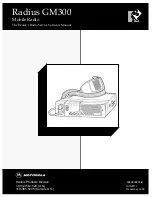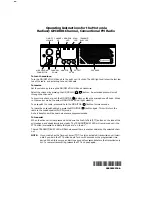
9
B. RF Board
The Spectra RF board contains the common syn-
thesizer circuits and dual-conversion demodulation
circuits. A four-pole crystal filter at 109.65 MHz pro-
vides first IF selectivity; the filter’s output is fed directly
to the custom IF/demodulator IC. An amplifier (at
109.65 MHz), the second mixer, the second IF ampli-
fiers (at 450 kHz), and the phase-lock-loop type
demodulator are on board the custom IC. Two ceramic
filters (designed for 12.5 kHz channel spacing) in the
second IF (450 kHz) provide noise selectivity for the
radio.
Synthesizing for the first and second VCO is per-
formed by the prescaler and synthesizer ICs. These ICs
are programmed via a serial data bus from signals gen-
erated on the command board. DC voltage, also
generated on the command board, sets the synthesiz-
er’s reference oscillator frequency of 16.8 MHz. This
voltage is controlled by the microprocessor system’s
digital-to-analog (D/A) converter, and is the only element
of the RF board requiring alignment on HRN6000A and
HRN6002A Kits.
The second local oscillator runs at 109.2 MHz (low-
side injection), and consists of a VCO which is
frequency-locked to the reference oscillator. Part of the
local oscillator’s circuitry is on-board the prescaler IC.
On all RF board kits other than HRN6000A and
HRN6002A, R6634 is adjusted in the factory to tune the
oscillator.
A clamp and rectifier circuit on the RF board gener-
ates a negative dc voltage of -6.25 volts (nominal) for
increasing the total voltage available to the first VCO
and second local oscillator’s VCO. The circuit receives a
300kHz square wave output from the prescaler IC, then
clamps, rectifies, and filters the signal for use as the
negative steering line for the two VCOs.
C. Voltage Controlled Oscillator (VCO)
The VCO assembly generates variable frequency
RF output signals controlled by the two steering lines.
The negative steering line increases the tuning range of
the VCO, while the positive steering line affects the syn-
thesizer control loop to incrementally change the
frequency.
The VCO generates a signal from the
412-471 MHz frequency range (see Table 3. VCO Fre-
quency). This signal is fed to the doubler/buffer circuit
which, in turn, doubles the VCO output frequency and
amplifies it to the power level required by the TX buffer
and RX first mixer. A set of PIN diodes switches the TX
or RX outputs on or off according to the keyed 9.4V con-
trol signal. The VCO assembly’s synthesizer feedback
output is the same as the VCO frequency (doubler
input). Nominal power levels are shown in Table 4.
D. HearClear
TM
Board
The HearClear board is an audio shaping circuit
designed to decrease the effects of multipath fading in
900 MHz bands that have 12.5 kHz channel separa-
tion. Multipath fading is more pronounced at 900 MHz
because of reduced system deviation. Primarily, through
dynamic attenuation and companding, the HearClear IC
reduces noise caused by fading.
In the HearClear IC, the flutter-fighter circuitry
dynamically attenuates the audio signal when either a
fade occurs or high-frequency noise (greater than 3
kHz) is present. Companding, similar to that used in
cellular radios, further reduces the audible effects of fad-
ing by lowering the noise floor of the audio signal.
E. Adaptive Transmit Control
The adaptive transmit control circuitry reduces adja-
cent-channel interference for the 12.5 kHz channel
spacing in the 900 MHz mobile frequency band.
The received signal strength is continuously sam-
pled, and a history of the last several seconds is
recorded. The peak signal over this time is compared to
a factory-stored value in internal EEPROM. This thresh-
hold value corresponds to a signal strength of
approximately -55 dBm. Each time the PTT is pressed,
the comparison is made. If the received signal was
stronger, reduced transmit parameters (power, devia-
tion, and splatter) are used. If the received signal is less
than the threshold for the previous 10 seconds, full
transmit parameters are used.
Full parameters are used for trunking ISW and
talkaround, regardless of the received signal history.
Mode
AUX 1
AUX 2
VCO Freq. Range ( MHz)
Doubler-buffer Output ( MHz)
RX
HIGH
HIGH
412.675 – 415.675
825.35 – 831.35
TX
HIGH
LOW
448 – 451
896 – 902
TA
LOW
LOW
467.5 – 470.5
935 – 941
Table 3. VCO Frequency
Item
RX Mode
TX Mode
TA Mode
RX Injection
+3.5
–10
–10
TX Injection
–
+21
+21
Synthesizer Feedback
–5
–5
–5
Table 4. VCO Power Output (Typical, dBm)
Содержание Spectra
Страница 6: ...v PERFORMANCE SPECIFICATIONS FOR SPECTRA PRIVACY PLUS TRUNKED CONVENTIONAL 900 MHz RADIO ...
Страница 7: ...vi PERFORMANCE SPECIFICATIONS FOR SPECTRA SMARTNET TRUNKED CONVENTIONAL 900 MHz RADIO ...
Страница 8: ...vii PERFORMANCE SPECIFICATIONS FOR SPECTRA 9000 RADIOS 900 MHz 30 WATTS ...
Страница 25: ...1 GENERAL INFORMATION 1 ...
Страница 73: ...53 INSERT GPW 7221 B Figure 22 Front Panel Diagnostics Key Closure Displays ...
Страница 75: ...INSERT GXW 4278 O PICKUP FROM PW 4320 O 55 CONTROL STATION WIRING DIAGRAM ...
Страница 79: ...PUSHBUTTON SPECTRA 900 MHz RADIO MECHANICAL EXPLODED VIEW 59 INSERT GXW 6225 B ...
Страница 96: ...82 MECHANICAL EXPLODED VIEW PARTS LIST FOR SPECTRA 900 MHz RADIO ...
















































